
| KIT: | Academy 1/48 P-47D Thunderbolt |
| KIT #: | 2159 |
| PRICE: | 30 Swiss Francs |
| DECALS: | See Review |
| REVIEWER: | Pierre-André Boillat |
| NOTES: |
Aeromaster 48-081 decals used. The “other” Thunderbolt kit – well worth a closer look ! |

| HISTORY |
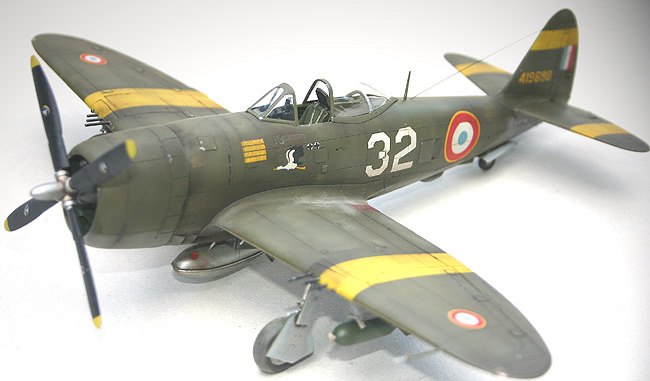
After so many Thunderbolt reviews made by excellent writers, I guess no one needs another lecture about this most famous aircraft’s technical development or brilliant operational career (at least in US service). So I’ll concentrate on this review’s subject, which is much lesser known : the P-47 in French service.
The new birth of the Armée de l’Air … a long story in a few words.
After the Allied invasion of French North Africa, the main part of France’s air force, which the Vichy government had withdrawn to the colonies after the 1940 defeat – and had fought against the British or Americans on several occasions – went back on the Allied side. Of course, several problems arose at once.
First, re-uniting the former Vichy Air Force and the Free French Air Force
– both sides looking at the other one with disdain and resentment - proved
to be a true political can of worms, as was having the proud Armée de l’Air
serving under US tactical command… G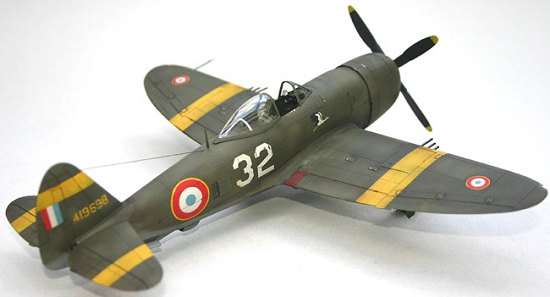 eneral Eisenhower had a rather busy
time with Charles De Gaulle and his staff, who were eager to strengthen
France’s political position in post-war Europe, and never missed an
occasion to wave the flag and act… let’s say… very independently.
eneral Eisenhower had a rather busy
time with Charles De Gaulle and his staff, who were eager to strengthen
France’s political position in post-war Europe, and never missed an
occasion to wave the flag and act… let’s say… very independently.
The other problem was – as big as it was – easier to solve : the Armée de l’Air’s material was desperately obsolete (most of its aircraft being war-weary machines that had seen the battles of 1940 – the Free French being equipped with old British material), and the personnel had no experience with modern Allied aircraft, procedures or tactics.
First, second-hand or second-rate equipment was provided for training in North Africa, until the New French Air Force, having proven its skills and dedication to the Allied cause, was considered fit to carry the fight to Italy and France… this time with large numbers of much better aircraft (I’m not speaking of the war-weary P-39 Airacobras which were replaced with P-63s only after war’s end), the spearhead of the Armée de l’Air’s fighter-bomber force being 6 “groupes de chasse” of P-47 Thunderbolts, the air-superiority role being held by seven groups of Spitfire IXs.
The French Thunderbolts in WWII
Originally
operating from Italy, then from Sardinia and Corsica until the Provence
landings, mainly flying missions against German and R.S.I troops in
northern Italy and the French Alps, the P-47 units then followed the Allied
armies from airfield to airfield up the Rhône valley to Dauphiné,
Bourgogne, Franche-Comté, Alsace and Lorraine, crossing the Rhine in April
45 and ending the war in southern Germany, some Thunderbolts being used
against the German-held harbors of the Atlantic coast until the very last
day. Their combat records show heavy losses and only few aerial victories…
the reason for this is  that the French Thunderbolts were used mainly for
ground attack – rarely meeting a Luftwaffe that had become elusive, and
playing a daily, deadly low-level attrition game against the Flak, mauling
German trains and convoys, and more than once saving the day for the ground
troops that had to face fierce resistance and brutal counter-attacks. A
muddy, dangerous, unglamourous yet vital job performed under sometimes
terrible weather conditions that won them the respect of their allies.
that the French Thunderbolts were used mainly for
ground attack – rarely meeting a Luftwaffe that had become elusive, and
playing a daily, deadly low-level attrition game against the Flak, mauling
German trains and convoys, and more than once saving the day for the ground
troops that had to face fierce resistance and brutal counter-attacks. A
muddy, dangerous, unglamourous yet vital job performed under sometimes
terrible weather conditions that won them the respect of their allies.
After war’s end, the remaining 131 “lend-lease” P-47s were given to France and stayed for 16 more years in service, flying their last combat missions in 1957 during the Algeria war (none of them seeing active service in Indochina). The last machines were written off in 1960, long after the Armée de l’Air had entered the “jet age”.
The subject of this review is a P-47 D-28-RE of Groupe de Chasse II/5 “La Fayette”, flying from Ambérieu (a small town between Lyon and Geneva) in September 1944.
| THE KIT |
Released just before Hasegawa’s P-47, which itself has been almost outclassed by Tamiya’s, the Academy Thunderbolt was warmly welcomed by the modeling community (“at last a correct “Bubbletop” with engraved panel lines ! Hurrah !” was the battle cry…), until the “major companies” came along… Academy’s effort was a vast improvement compared to the (already quite good – yet plagued by shape issues) Monogram kit, and still has loads of modeling fun to offer… let’s have a look inside that large, well-illustrated box :
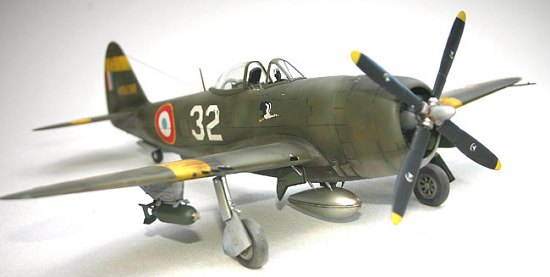 5 sprues of crisply injected, light grey plastic and one of (very) clear
styrene with narrow, yet deep panel lines (that will take “washes” easily),
offering lots of goodies like a complete set of armament (500 and 1’000lb
GP bombs, rockets, “bazooka” rocket tubes, and open gunbays), excellent
“regular” or “weighted” wheels, and four different types of drop tanks.
5 sprues of crisply injected, light grey plastic and one of (very) clear
styrene with narrow, yet deep panel lines (that will take “washes” easily),
offering lots of goodies like a complete set of armament (500 and 1’000lb
GP bombs, rockets, “bazooka” rocket tubes, and open gunbays), excellent
“regular” or “weighted” wheels, and four different types of drop tanks.
Detail level in the critical engine, cockpit and wheel well areas is very good – but to be honest, Hasegawa and Tamiya are even better. The large engine cowling comes in two halves, which brings about some filling and sanding. Decals include two machines, the world-famous “Eileen” with her wasp and chequered nose, and a natural metal 86th FG plane with red and white striped-tail operating in Italy.
All-in-all, what you get for a reasonable price is an outstanding kit whose quality would still be sung in high tones if it weren’t for the two “other” ones…
| CONSTRUCTION |
Be ready for a modeling joyride ! This kit loves to be put together… of course, you won’t get dropped flaps or a separate cowling ring, but if you like it simple, you’re at the right place !
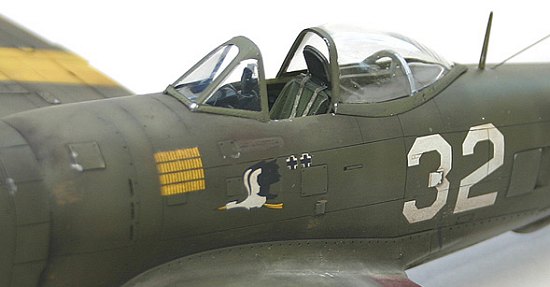 Get me right, “simple” doesn’t mean “crude”, and this P-47, once built,
will stand any comparison with its more advanced (and expensive) cousins.
I’d just advise you to leave the gunbays closed if you don’t want to
superdetail this area… the MGs provided are pretty, but the bay itself
isn’t good enough. That would be my only critic. This gadget wasn’t
necessary, and in return, more engineering work could have been invested in
the cockpit. At least, no filling and sanding is necessary once the panels
are closed…
Get me right, “simple” doesn’t mean “crude”, and this P-47, once built,
will stand any comparison with its more advanced (and expensive) cousins.
I’d just advise you to leave the gunbays closed if you don’t want to
superdetail this area… the MGs provided are pretty, but the bay itself
isn’t good enough. That would be my only critic. This gadget wasn’t
necessary, and in return, more engineering work could have been invested in
the cockpit. At least, no filling and sanding is necessary once the panels
are closed…
Fit is excellent, with only few putty being used. Given the large choice of external loads, the locating holes are supposed to be drilled from inside the wing undersurfaces, which leaves the option of building the aircraft in a “clean” configuration without having to fill them. The tailwheel well and doors come as a strong, single piece which fits nicely – a clever idea that will spare you some tricky fiddling (you know how those tailwheels can be !). The turbo-compressor’s air intakes can be placed in the open or closed position.
The final details
I chose to represent the typical external loads carried by the French
Thunderbolts : according to almost all pictures of “loaded” aircraft
available to me, they seemed to sport a small drop tank on the centerline
and two 500 lb GP bombs most of the time. Apparently, the missions were not
long-range ones, and the enemy – though still very dangerous – apparently
had nothing left worth a pair of 1’000 pounders that would slow down the
plane and shorten its range... I added a small personal
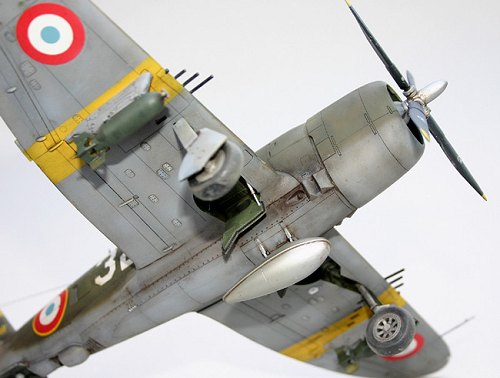 touch by painting
the drop tank aluminium – as some French P-47s flew in the natural metal
finish – or alongside US squadrons, I decided this tank had been “borrowed”
from another aircraft.
touch by painting
the drop tank aluminium – as some French P-47s flew in the natural metal
finish – or alongside US squadrons, I decided this tank had been “borrowed”
from another aircraft.
As said above, the clear parts are of sterling optical quality – as usual, I installed them last. I recommend to represent the canopy open, as they don’t seem to fit together very well. The MG cover in the wing leading edge comes separately, as do the gun barrels – don’t forget to glue them in the typical nose-down “parallel to the ground” position, or else someone will easily expose your error at an exhibition !
Only one propeller is provided – the Curtiss Electric cuffed & paddle-bladed one… by chance, it was the correct type for my French bird, so I didn’t have to steal it from the Tamiya kit (which was my intention at first – the darn thing has three props anyway !). You may choose to do so, but after comparing both parts, I decided to stay with Academy’s, as it is decent enough.
At last, I added the position lights, antennae and pitot tube, as they always get broken if installed earlier.
| COLORS & MARKINGS |
One thing about an OD/NG scheme is that it will easily look dull and
boring if no shading job is applied… I hence performed a complete range of
all the known weathering tricks : pre-shading, a wash of burnt
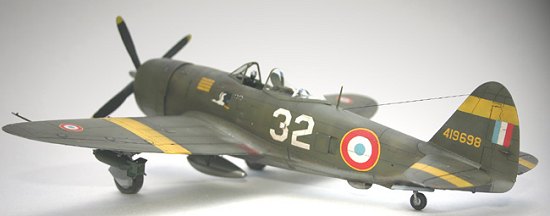 umbra oils, and, as the
first matt coat applied after the decaling had somewhat flattened out my
efforts, post-shading, a second wash + a little brush-applied pastel
powder. A lot of work, but well worth the pain. I must say I’m quite
pleased with the results.
umbra oils, and, as the
first matt coat applied after the decaling had somewhat flattened out my
efforts, post-shading, a second wash + a little brush-applied pastel
powder. A lot of work, but well worth the pain. I must say I’m quite
pleased with the results.
Academy’s decal sheet provides a complete range of stencils (I confess I didn’t apply them all). Be very cautious, however, as they tend to silver a bit, even on a glossy coat. Aeromaster’s French markings went on without a problem… they just gave me a lot of work, as a single cockade comes in 4 pieces (red and white circle, the blue spot, and two yellow half-borders)… which avoids them to be off-register, of course . If they end up being so, it will be entirely your fault ! The colours are spot-on, and they stick very well – with a little softener. The AM sheet also includes a B-26 and a Bearcat from the Indochina war.
| CONCLUSIONS |
What a pleasing kit ! Although I’m a fan of the P-47, this one was my first 1/48 Bubbletop, and I enjoyed every minute of the experience. Of course, the Hasegawa and Tamiya Thunderbolts in my stash have since become even more appealing – if the “lesser” Academy kit was that good, I can’t imagine the bliss it will be to build the “better” ones !
Anyway, I can’t but highly recommend this model. It has recently been re-released, and currently retails for $16.29 at Hobby Link Japan.
PS: Have you noticed ? I didn’t say “Jug” a single time !
September 2004
| REFERENCES |
Squadron Signal “Thunderbolt in Action”
Le Fana de l’Aviation : special issue “L’Honneur des Ailes Françaises – 1943-1945”
Aero Journal Nr. 24 : « La route du Rhin »
« P-47 Thunderbolt en Action » - a French revised issue of « P-47 Thunderbolt at war » by W. N. Hess with lots of additional material about French P-47s. – Editions E.P.A, 1982
If you would like your product reviewed fairly and quickly by a site that has over 250,000 visitors a month, please contact me or see other details in the Note to Contributors.